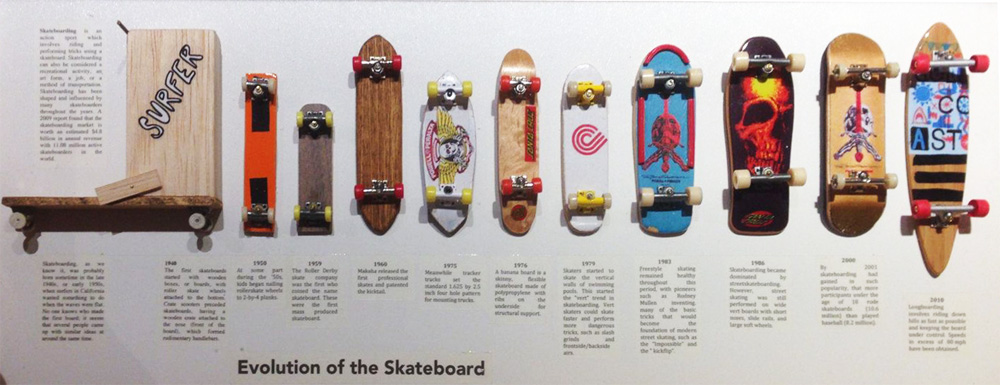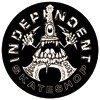Buying advice - Skateboard
![]() From simple wooden planks in the 1950s , a decade later we moved on to the first production of skate decks. The 70s are those of tests on materials (wood, fiberglass, plexiglass, aluminum ...) on the shape (no nose, spoon nose, punk point, hammer head, kicktail, double kicktail, etc ...) and grip which becomes a standard. Little evolution then until the arrival of the construction in laminated maple. In the 80s, the boards became wider, more concave, the tails more pronounced and we will see the fishtail, cutaway, hips, jagged rails… The pro models all have original shapes, designed by the pro riders.
From simple wooden planks in the 1950s , a decade later we moved on to the first production of skate decks. The 70s are those of tests on materials (wood, fiberglass, plexiglass, aluminum ...) on the shape (no nose, spoon nose, punk point, hammer head, kicktail, double kicktail, etc ...) and grip which becomes a standard. Little evolution then until the arrival of the construction in laminated maple. In the 80s, the boards became wider, more concave, the tails more pronounced and we will see the fishtail, cutaway, hips, jagged rails… The pro models all have original shapes, designed by the pro riders.
![]() At the start of the 90s, with the disappearance of Freestyle, the virtual death of the Green and the rise of Street Skating, the shape of boards was standardized. We still skate today on this type of shape. The only notable change in the last two decades: the width of the boards. It declined considerably around the 2000s to drop to a standard of 7.5 'and meet the needs of technical streeters.
At the start of the 90s, with the disappearance of Freestyle, the virtual death of the Green and the rise of Street Skating, the shape of boards was standardized. We still skate today on this type of shape. The only notable change in the last two decades: the width of the boards. It declined considerably around the 2000s to drop to a standard of 7.5 'and meet the needs of technical streeters.
![]() In recent years, with the return of bowls and concrete skateparks, boards have gained momentum for a new generation of “all terrain” skateboarders. The average board width today is 8.2 '.
In recent years, with the return of bowls and concrete skateparks, boards have gained momentum for a new generation of “all terrain” skateboarders. The average board width today is 8.2 '.

![]() Here are some important criteria in choosing a board
Here are some important criteria in choosing a board
The shape
This is the general shape of the board. We will retain two essential points.
The width
Expressed in inches, a board is considered to be thin below 7.8 'and wide above 8.5' (to be qualified according to the size and the template). A thin board will be lighter and will make it easier to perform technical figures (flip, 360 flip ...) while a wide one will be more stable and stronger.
![]() INCH '/ CM conversion table
INCH '/ CM conversion table
| Inch ' | 7.4 | 7.5 | 7.6 | 7.7 | 7.8 | 7.9 | 8 | 8.13 | 8.2 | 8.25 | 8.3 | 8.4 | 8.5 | 8.6 | 8.7 | 8.8 | 8.9 | 9 | 9.5 | 10 |
| Cm | 18.8 | 19.05 | 19.30 | 19.56 | 19.81 | 20.07 | 20.32 | 20.64 | 20.83 | 20.96 | 08.21 | 21.34 | 21.59 | 21.84 | 22.10 | 22.35 | 22.51 | 22.86 | 24.13 | 25.40 |
The concave
It is above all a question of taste. There are three types of concave: light, medium and strong. The more concave the board, the more the feet are set, and the figures are executed faster. A weak concave will be easier to control in flat. For example, Natas Kaupas came home from flips in 1988 with a 10 inch wide board, so there is no reason to fail with an 8.2 with or without a concave.
The brand
Clearly: “one brand over another won't make you better skate”. However, skateboarding is a way of life and each brand cultivates its identity through the graphics of the boards, the skateboarders it sponsors, the music of its videos ... Thus Girl, Chocolate, Alien Workshop, Habitat ... are oriented on a technical, clean and professional skate. Cliché, Antiz, Trauma, Metropolitan, Magenta… represent European skateboarding. Zero, Deathwish, Baker… work a darker image with a pronounced taste for big gaps and rails. Toy Machine, Krooked… are artists' brands, who make their own decorations and bring a touch of originality. Finally, BIackLabel, AntiHero, Creature… are very strong brands with versatile and creative skaters who can skate all terrains.
The Grip, more info: "Genuine Parts" buying advice
In conclusion, each brand has its own image and conveys certain values. At INDEPENDENT SKATESHOP, we believe it is important to know who you are giving your money to and favoring one trend over another.
The prices include the grip and vary according to the type of products offered. We will distinguish 4 main categories:
- The Nude board, € 39, for small budgets and / or first board.
- The European brand board from € 60 to € 70.
- The American brand board from € 70 to € 90.
- The limited edition or reissue board from € 85 to € 125.
Since the boards we offer are very similar in manufacture, the price differences can be explained as follows: the designs that are on the board and the costs that this entails (graphic designer, screen printing or flashing), pro skateboarders to sponsor and brand communication budgets, the multitude of shapes available at the same time, and the number of intermediaries. Thus the Nude has a good shape but offers a reduced choice of sizes, no decoration, while the pro model of a US brand offers very different shapes, benefits from communication budgets, in addition to a remuneration for the skater whose name is on the board.

